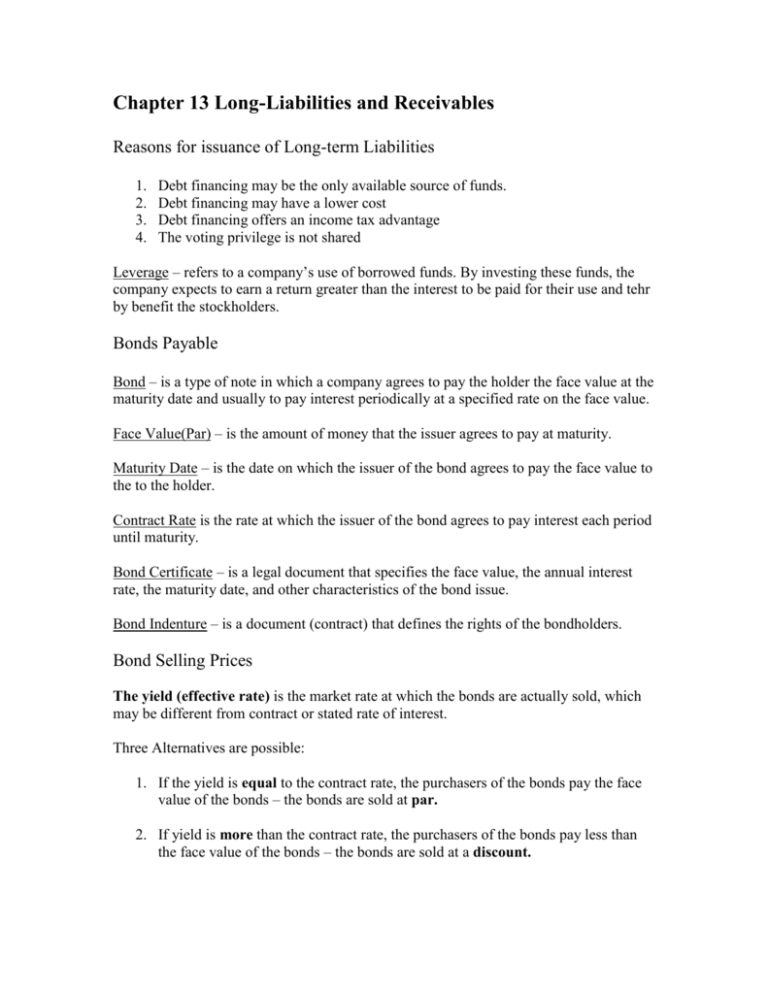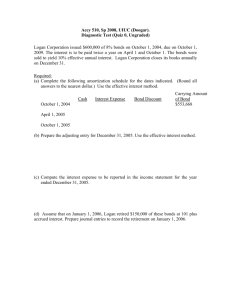Chapter 13 Long-Liabilities and Receivables
advertisement

Chapter 13 Long-Liabilities and Receivables Reasons for issuance of Long-term Liabilities 1. 2. 3. 4. Debt financing may be the only available source of funds. Debt financing may have a lower cost Debt financing offers an income tax advantage The voting privilege is not shared Leverage – refers to a company’s use of borrowed funds. By investing these funds, the company expects to earn a return greater than the interest to be paid for their use and tehr by benefit the stockholders. Bonds Payable Bond – is a type of note in which a company agrees to pay the holder the face value at the maturity date and usually to pay interest periodically at a specified rate on the face value. Face Value(Par) – is the amount of money that the issuer agrees to pay at maturity. Maturity Date – is the date on which the issuer of the bond agrees to pay the face value to the to the holder. Contract Rate is the rate at which the issuer of the bond agrees to pay interest each period until maturity. Bond Certificate – is a legal document that specifies the face value, the annual interest rate, the maturity date, and other characteristics of the bond issue. Bond Indenture – is a document (contract) that defines the rights of the bondholders. Bond Selling Prices The yield (effective rate) is the market rate at which the bonds are actually sold, which may be different from contract or stated rate of interest. Three Alternatives are possible: 1. If the yield is equal to the contract rate, the purchasers of the bonds pay the face value of the bonds – the bonds are sold at par. 2. If yield is more than the contract rate, the purchasers of the bonds pay less than the face value of the bonds – the bonds are sold at a discount. 3. If the yield is less than the contract rate, the purchasers of the bonds pay more than the face value of the bonds – the bonds are sold at a premium. Recording the Issuance of Bonds At the time of sale the company records the face value of bonds in a Bonds Payable account, and it records any premium or discount in a separate account entitled Premium on Bonds Payable or Discount on Bonds Payable. Example: Assume the company issues bonds with a face value of $400,000 on the authorization date at 102. Cash ( 400,000 x 1.02) Bonds Payable Premium on Bonds Payable 408,000 400,000 8,000 Book (Carrying) Value – of a bond issue at any time is the face value plus any unamortized premium or minus any unamortized discount. Bonds Issued Between Interest Payment Dates Bonds are often sold after their authorization date and between interest payment periods. When a company sells bonds between interest dates, to reduce the record keeping for the first interest payment, the company normally will collect from the investors both the selling price and the interest accrued on the bonds from the interest payment date prior to the date of sale. Example: A company issues $800,000 on March 1, 2001 of 10-year 12% coupon bonds dated January 1, 2001 at par. Interest is paid semiannually on January 1 and July 1. The following entry would be recorded on March 1, 2001: Cash 816,000 Interest Expense Bonds Payable 16,000 800,000 On July the semiannual interest payment would be recorded: Interest Expense ($800,000 x 0.12 x 6/12) Cash 48,000 48,000 It is possible to record the previous transaction by using a liability account that reflects the fact that part of the proceeds (i.e., the accrued interest) will be repaid in the future. The following entry represents this: Cash 816,000 Interest Payable Bonds Payable 16,000 800,000 On July 1, 2001 the first interest payment would be recorded as follows: Interest Expense ($800,000 x .12 x4/12) Interest Payable Cash 32,000 16,000 48,000 Amortizing Discounts and Premiums Effective Interest Method The effective interest expense amount is computed by multiplying the effective interest rate time the book value of the bonds at the beginning of the period. To determine the selling price and the related discount (premium) the effective rate is applied to both the future principal and periodic interest payments Amortization is the difference between the amount of interest expense and the cash payment. The amount of interest expense using this method reflects a constant rate based upon the remaining book value of the bonds. Straight-line Method When using the straight-line method the discount or premium is amortized to interest expense in equal amounts each period during the life of the bonds. The straight-line method results in a constant amount of interest expense each semiannual period. Bond Issue Costs APB Opinion No. 21 requires that a company defer any expenditures connected with a bond issue such as legal and accounting fees, printing costs, or registration fees. Accruing Bond Interest In cases where bonds are issued with interest payments dates that differ from the fiscal year the matching principle requires than an accrual of interest and partial premium or discount or amortization be recorded at the end of the fiscal year. Zero Coupon Bonds are sold at a “deep” discount and pay no interest each period. But interest expense must be recognized as it is incurred over the period. Extinguishment of Liabilities Under FASB Statement No. 125 a liability is considered extinguished for financial reporting purposes if either of the following occurs: 1. The debtor pays the creditor and is relieved of its obligation for the liability. This payment may take place at maturity, or prior to maturity by recall or by reacquisition. 2. The debtor is released legally from being the primary obligor under the liability, either by law or by the creditor. Call Provisions allow a company to recall the debt issue at a prestated percentage of the face value prior to the maturity date. Bonds with Equity Characteristics A company may issue bonds that allow creditors to ultimately become shareholders either by attaching stock warrants to the bonds or including a conversion feature in the bond indenture. Stock Warrants – represent rights that enable the security holder to acquire a specified number of common shares at a given price within a certain time period. A portion of the proceeds of bonds issued with detachable warrants must be allocated to the stock warrants and accounted for as additional paid in capital. The allocation made is as follows: Amount Assigned = Market Value of Bonds without Warrants x Issuance Price Bonds Market Value of Bonds + Market Value Without Warrants of Warrants Amount Assigned = _____Market Value of Warrants_____ x Issuance Price To Warrants Market Value of Bonds + Market Value Without Warrants of Warrants Convertible Bonds – at conversion the bondholder exchanges the bonds for a specified number of common shares and becomes a stockholder. The conversion may be recorded with either the Book Value Method or the Market Value Method. Long-term Notes Payable A long-term note is similar to a debenture bond because it represents a future obligation of the borrower to repay debt, and in many cases no collateral backs the note. The note is recorded at its present value and the effective interest method is used to record the subsequent interest. The incremental interest rate is the rate that the borrower would be required to pay to obtain similar financing in the credit market at the time the note is issued. Notes Payable Issued for Cash When a long-term non-interest bearing note is exchanged solely for cash, the note is assumed to have a present value equal to the cash proceeds. The difference between the cash proceeds and the face value of the note is recorded as a discount and amortized over the life of the note by the effective interest method. The effective (implicit) interest rate is the rate that equates the future value on the present value. Example: Company issues a 3-year non-interest bearing note with a face value of $8,000 and receives 5,694.24 in proceeds. Cash Discounts on Notes Payable Notes Payable 5,694.24 2,305.76 8,000 Company records interest expense for the first year as follows Interest Expense ($5,694.24 x 0.12) Discounts on Notes Payable 683.31 683.31 Notes Payable Exchanged for Cash and Rights or Privileges The note is recorded at its present value at the time of issuance by discounting the maturity value using the incremental interest rate of the borrower. Interest expense is recorded over the life of the note using the effective interest method. The difference between cash proceeds and the present value of the note is recorded as unearned revenue and revenue is recognized over the life of the contract using appropriate revenue recognition criteria. Notes Payable Exchanged for Property, Goods, or Services The notes is recorded at the fair value of the property, goods, or services, or the fair value of the note, whichever is more reliable. If neither of these fair values is determinable, the note is recorded at its present value by discounting the future cash flow(s) using the incremental interest rate of the borrower. Long-term Notes Receivable The note receivable is recorded at the fair value of the property, goods, or services or the fair value of the note whichever is more reliable. If neither of these values is reliable, the note is recorded at its present value by using borrower’s incremental interest rate.









